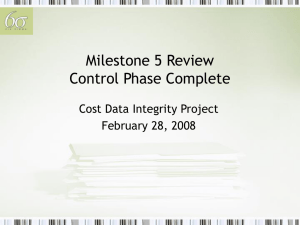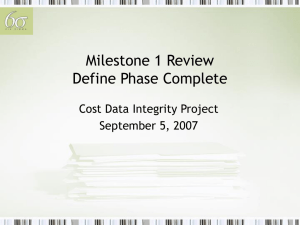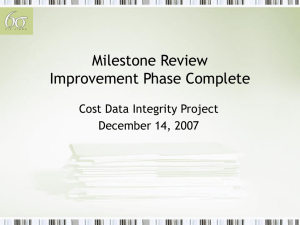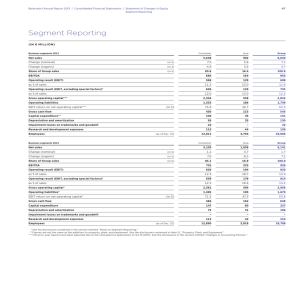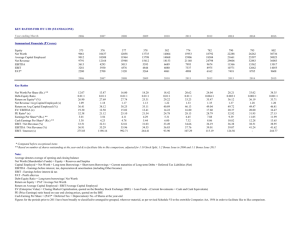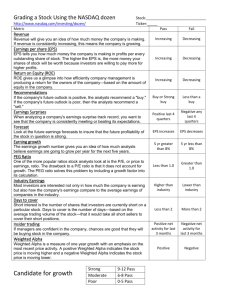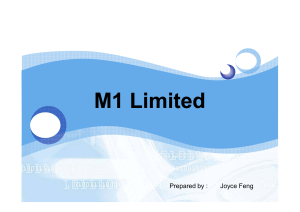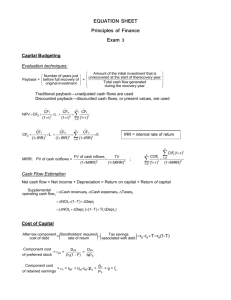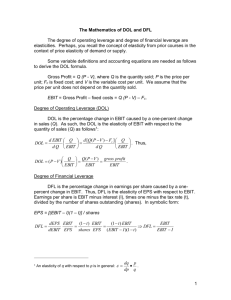Discussion Board Articles on Capital Structure
advertisement
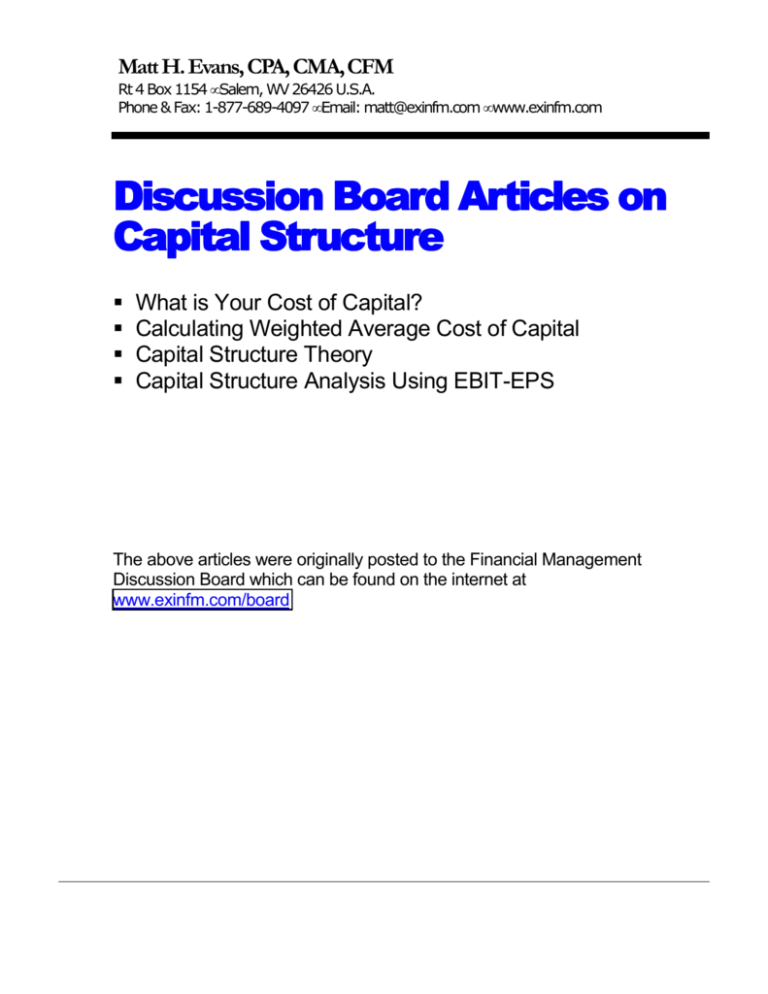
Matt H. Evans, CPA, CMA, CFM Rt 4 Box 1154 • Salem, WV 26426 U.S.A. Phone & Fax: 1-877-689-4097 • Email: matt@exinfm.com • www.exinfm.com Discussion Board Articles on Capital Structure ! ! ! ! What is Your Cost of Capital? Calculating Weighted Average Cost of Capital Capital Structure Theory Capital Structure Analysis Using EBIT-EPS The above articles were originally posted to the Financial Management Discussion Board which can be found on the internet at www.exinfm.com/board What is Your Cost of Capital? There is a cost of doing business that must serve as your benchmark for how you invest in long-term assets. This costs is called Cost of Capital. Cost of Capital is the rate you pay to those who lend or invest money into your business. You can think of Cost of Capital as the rate of return investors require for incurring risk whenever they give you money. Cost of Capital applies to long-term funding of assets as opposed to short-term funding of working capital. Why is Cost of Capital so important? Well, you have to earn an overall rate of return on your assets that is higher than your cost of capital. If not, you end-up destroying value. So how do you calculate Cost of Capital? The most popular approach is called the Capital Asset Pricing Model or CAPM. CAPM estimates your cost of equity by taking a risk free rate and adjusting it by risks that are unique to your company or industry. Long-term government bonds are often used to estimate risk free rates while overall market premiums run around 6%. CAPM is not perfect since it has many unrealistic assumptions and variations in estimates. For example, sources (Bloomberg, S & P, etc.) for reporting market risks of specific companies provide very different estimates. Additionally you might find simple estimates are just as accurate as CAPM. For example, simply adding 3% to your cost of debt may provide a reasonably accurate estimate of your cost of capital. You can also look at companies that are very similar to your company. In any event, you need to calculate your cost of capital since it is an extremely important component in financial management decision making. - Matt H. Evans, www.exinfm.com Calculating Weighted Average Cost of Capital Weighted Average Cost of Capital (WACC) is the overall costs of capital. WACC is based on your current capital structure. Market values are used to assign weights to different components of capital. It should be noted that market weights are preferred over book value weights since market values more closely reflect how you raise your capital. Market weights are calculated by simply dividing the market value for each component by the sum of market values for all components. The following example illustrates how you calculate weighted average cost of capital: Current Capital Structure consists three components: Long-term Debt (10 year A Bonds) with a book value of $ 400,000 and a cost of capital of 6.0%. Common Stock with a book value of $ 200,000 and a cost of capital of 18.0%. Retained Earnings with a book value of $ 50,000 and a cost of capital of 16.0%. 2 1. Determine Market Values for Capital Components. 10-Year grade A bonds are selling for $ 1,150 per bond and the common stock is selling for $ 40.00 per share. Assume we have 500 bonds outstanding and 15,000 shares of stock outstanding. Market Value for Debt is $ 575,000 ($ 1,150 x 500) and Market Value for Stock is $ 600,000 ($ 40.00 x 15,000). 2. Allocate the Equity Market Value between Common Stock and Retained Earnings based on book values. Common Stock = $ 480,000 ($ 200,000 / $ 250,000 x $ 600,000). Retained Earnings = $ 120,000 ($ 50,000 / $ 250,000 x $ 600,000). 3. Calculate the WACC using market weights: The Debt (Bonds) has a market weight of .49 ($ 575,000 / $ 1,175,000) x .06 cost of capital = .029. Stock has a market weight of .41 ($ 480,000 / $ 1,175,000) x .18 cost of capital = .074. Finally, Retained Earnings has a market weight of .10 ($ 120,000 / $ 1,175,000) x .16 cost of capital = .016. This gives us a Weighted Average Cost of Capital of .119 or 11.9% (.029 + .074 + .016). - Matt H. Evans, www.exinfm.com Capital Structure Theory The theory behind capital structure is to find the right mix of long-term funds that minimizes the costs of capital and maximizes the value of the organization. This ideal mix is called the optimal capital structure. It can be argued that an optimal capital structure really doesn't exist since changing the mix of capital will not change values. However, four approaches can be used to find the optimal capital structure. They are Net Operating Income (NOI), Net Income (NI), Traditional, and Modigliani-Miller. It should be noted that all of these approaches assumes no income taxes exists, all residual earnings are distributed as dividends, and operating risks remain consistent. The NOI approach holds that costs of capital is relatively the same regardless of the degree of leverage. The NI approach takes the opposite view; costs of capital and market values of companies are affected by the use of leverage. The Traditional Approach is a mix of both the NOI approach and the NI approach. Finally, the Modigliani-Miller view is that costs of capital and market values are independent of your capital structure. In practice, there are lots of factors that influence capital structure. They include growth in sales, asset composition, risk attitudes within the organization, etc. The best approach seems to be to focus on a range of capital structures in managing the organization. - Matt H. Evans, www.exinfm.com 3 Capital Structure Analysis Using EBIT-EPS One way of determining the right mix of capital is to measure the impacts of different financing plans on Earnings Per Share (EPS). The objective is to find the level of EBIT (Earnings Before Interest Taxes) where EPS does not change; i.e. the EBIT Breakeven. At the EBIT Breakeven, EPS will be the same under each financing plan we have under consideration. As a general rule, using financial leverage will generate more EPS where EBIT is greater than the EBIT Breakeven. Using less leverage will generate more EPS where EBIT is less than EBIT Breakeven. EBIT Breakeven is calculated by finding the point where alternative financing plans are equal according to the following formula: (EBIT - I) x (1.0 - TR) / Equity number of shares after implementing financing plan. I: Interest Expense TR: Tax Rate Formula assumes no preferred stock. The formula is calculated for each financing plan. For example, you may be considering issuing more stock under Plan A and incurring more debt under Plan B. Each of these plans will have different impacts on EPS. You want to find the right plan that helps maximize EPS, but still manage risks within an acceptable range. EBIT-EPS Analysis can help find the right capital mix for high returns and low costs of capital. - Matt H. Evans, www.exinfm.com 4
